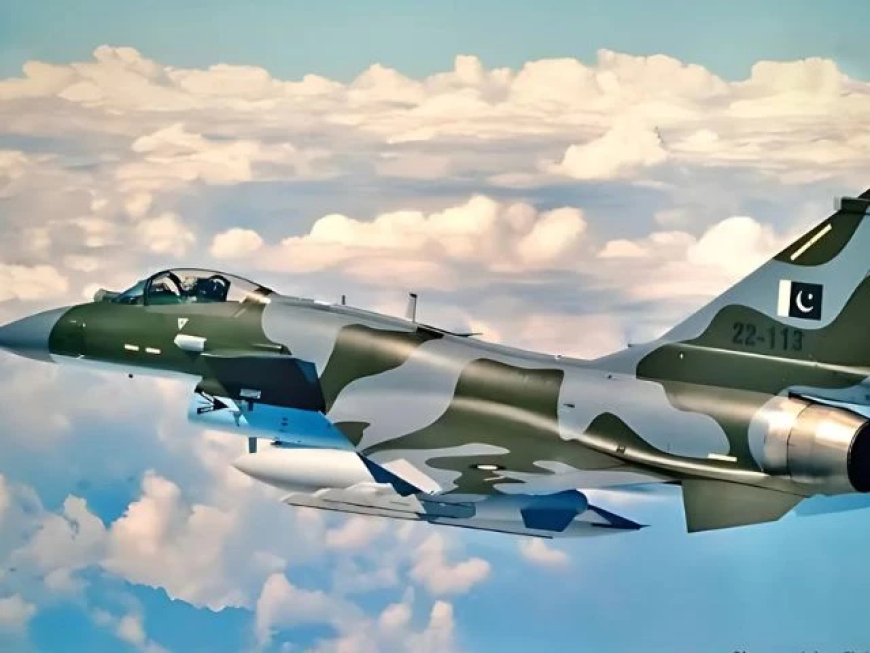PAF Forces Indian Rafale Jets to Flee Kashmir Skies
Tensions soared near the Line of Control (LoC) as reports emerged of Indian Rafale fighter jets being forced to retreat by the Pakistan Air Force (PAF). The high-stakes aerial encounter unfolded near the contested region of Kashmir, further intensifying the long-standing hostility between two nuclear-armed neighbors, Pakistan and India.

Tensions soared near the Line of Control (LoC) as reports emerged of Indian Rafale fighter jets being forced to retreat by the Pakistan Air Force (PAF). The high-stakes aerial encounter unfolded near the contested region of Kashmir, further intensifying the long-standing hostility between two nuclear-armed neighbors, Pakistan and India.
-
Indian Air Force (IAF) Rafale jets allegedly crossed the LoC into Pakistan-administered airspace.
-
Pakistan Air Force responded swiftly, scrambling fighter jets for interception.
-
The Indian jets retreated after radar locks and warning maneuvers from the PAF.
-
The incident reportedly occurred near the Neelum Valley sector.
-
No physical engagement or missile launch took place.
-
Both sides remain silent officially, but intelligence and media sources confirm high-alert status.
Indian Air Force: Rafale Jets
-
French-made 4.5-generation multirole fighters.
-
Equipped with Meteor air-to-air missiles and SCALP cruise missiles.
-
Advanced radar systems and electronic warfare capabilities.
-
Deployed in sensitive zones including Ladakh and Kashmir.
Pakistan Air Force Response Fleet
-
JF-17 Thunder: Co-produced by Pakistan and China, agile and combat-proven.
-
F-16 Fighting Falcon: US-origin aircraft known for precision and agility.
-
Radar Lock Systems: PAF used its ground and aerial radars to track intrusions.
According to defense insiders and local media reports:
-
Radar Activity Detected: PAF detected multiple aerial objects moving across the LoC.
-
Scrambling of Jets: Within minutes, PAF deployed its interceptor units.
-
Radar Lock and Warning: PAF jets established radar lock on the Rafale squadron, issuing warning signals.
-
IAF Retreated: The Indian jets turned back, reportedly avoiding direct engagement.
-
Alert Status Maintained: Both air forces remained on high alert for hours post-incident.
-
Message of Deterrence: Pakistan showcased its aerial defense readiness.
-
Kashmir Tensions Reignite: The region once again becomes a flashpoint for military action.
-
International Concern: Global powers closely monitor developments due to nuclear risks.

"This incident underlines the strategic balance in the region. While Rafales are technologically superior, air dominance depends on how forces respond in real time, and PAF demonstrated sharp reflexes."
"This wasn't just a technical encounter. It was a psychological pushback from Pakistan, showing it won't tolerate airspace violations."
In Pakistan:
-
Hashtags like #PAFZindabad and #AirForcePride trend on X (Twitter).
-
National media praised PAF’s “swift and disciplined” response.
-
Politicians called it a "timely defensive move."
In India:
-
Official silence maintained by the Indian Ministry of Defence.
-
Analysts downplayed the incident, calling it "routine air patrol."
-
Opposition parties questioned the Indian Air Force’s airspace protocol.
-
Both nations may increase aerial patrols near sensitive sectors.
-
Intelligence sharing with allies (e.g., China for Pakistan, France/USA for India) is likely to intensify.
-
Diplomatic channels remain quiet but under active surveillance by global organizations like the UN.
-
Nuclear Risk: Any escalation could potentially spiral into a full-blown conflict.
-
Regional Stability: Impacts China, Afghanistan, and even Central Asian geopolitics.
-
Trade & Tourism: Cross-border tensions often disrupt economic activity and tourism in the Kashmir region.
-
Global Watchdog Attention: Organizations like the UN and OIC monitor each incident closely.
While the recent incident did not involve any missile launch or dogfight, its importance lies in deterrence dynamics and aerial supremacy assertions. Both Pakistan and India must act with restraint and transparency to prevent accidental escalations in one of the world's most volatile regions.
The Pakistan Air Force’s swift response has once again demonstrated its preparedness, professionalism, and commitment to national security, earning widespread national support and global attention.

 ateeq.r
ateeq.r